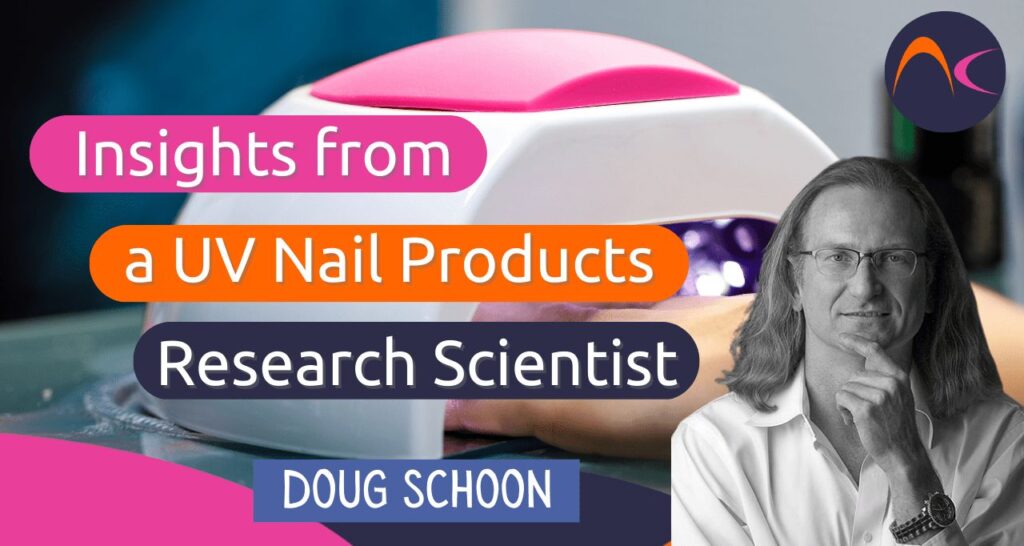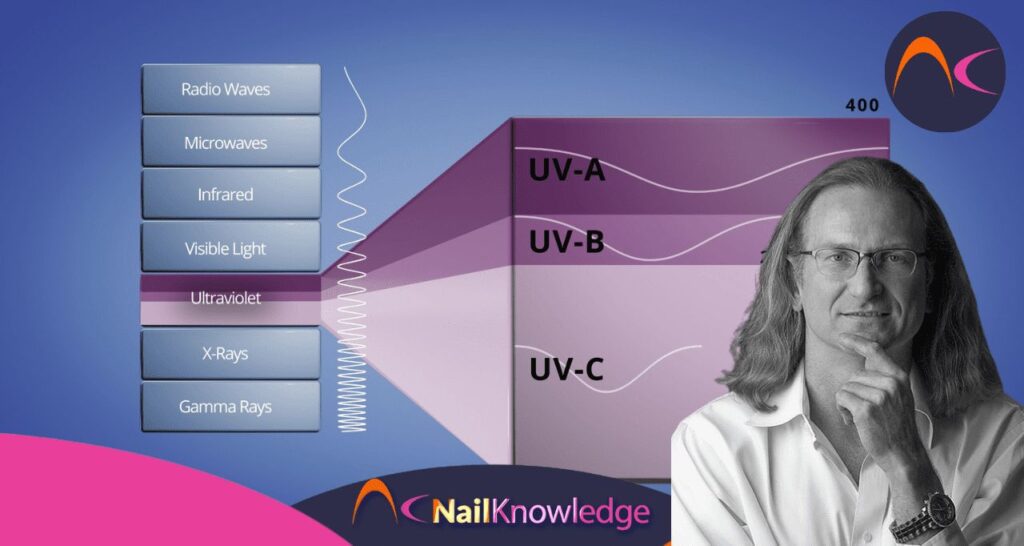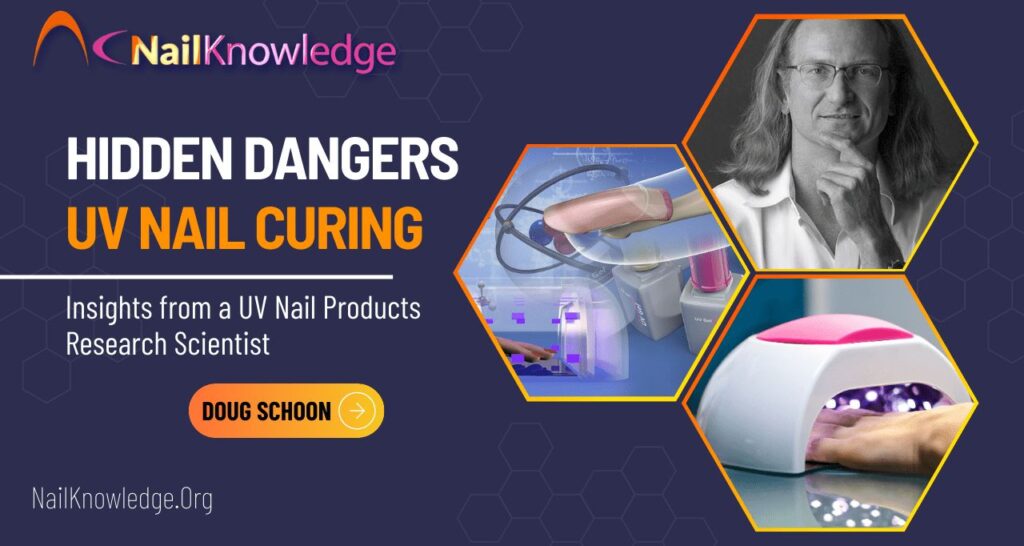There is no such thing as a Universal UV Nail lamp that properly cures any UV nail product; nor are there UV curing nail products that properly cure with any nail lamp. Those who are making these erroneous claims are contributing to the growing number of consumers and professionals developing skin irritation and persistent or permanent skin allergies that worsen over time.
Essential Information for Safe UV Cured Nail Services
Fortunately, with the information and solutions presented in this article, these problems will be much easier to avoid which will allow nail professionals to protect themselves and clients while providing safe and beautiful UV cured enhancements and gel polish services.
Insights from a UV Nail Products Research Scientist

As a research scientist, I have studied UV curing of nail products for more than 20 years and I’ve developed many UV curing nail products and UV nail lamps. I have also invented a unique scientific instrument designed to accurately test the curing of UV nail products under different UV nail lamps. I’ve performed testing on hundreds of different UV products using a wide variety of UV nail lamps containing either UV-emitting LEDs or CFLs (compact fluorescent tubes).
Contrary to what some believe, all nail lamps emit UV, even those that use LEDs. Exposure to UV is required for curing all types of UV products including UV cured enhancements and gel polish.
The current state of research on UV curing products and lamps
My research into these products and UV curing lamps is ongoing, therefore the information provided in this article reflects the present situation.
Understanding the Risks of Under Cured UV Nail Products
UV nail products can be under cured, over cured, or properly cured. The most common of these is under curing and it is a leading cause of skin irritation and allergy to both clients and nail professionals when they are exposed to under cured dust/filings or while soaking products off in remover. Unfortunately, nail professionals and clients can NOT determine when under curing occurs just by looking at the nails, nor can they tell by filing them. This is because UV cured products harden and can be filed when they are only 50% cured. The product looks and feels cured even when it has not polymerized (cured) to a safe level.
After the client leaves the nail salon, the UV enhancement and/or gel polish may only cure an additional 4-6%, so when under curing happens these nail services will likely remain under cured even as it is worn over the next few weeks. Under curing creates lower durability which causes cracking, breaking, lifting and loss of shine. However, the greater problem is that under curing dramatically increases the risk of developing adverse skin reactions such as skin irritation or allergy in both nail professionals and clients.
Dust and filings from under cured UV products contain significant amounts of uncured ingredients such as monomers and oligomers or other substances. Over time repeated exposure to these uncured substances can cause adverse skin reactions or trigger existing skin problems. Typical symptoms are redness, itching, swelling, water blisters, onycholysis, numbness, unusual sensitivity to heat and pressure or, in extreme conditions, a total loss of the nail plate. Continued use causes the symptoms to progress and worsen.
Four Key Factors for Proper UV Product Curing

Proper curing minimizes such problems which is why it is extremely important. There are four important factors for determining if a UV product will properly cure:
1. Range of UV wavelengths emitted by the nail lamp
2. Intensity of the emitted wavelengths
3. Time span of UV exposure
4. Thickness of the UV gel enhancement or polish
The Role of Photoinitiators in UV Curing of Nail Products
UV cured products contain specialized ingredients called photoinitiators without which proper curing would not be possible. Typically, photoinitiators are used between 1-5% concentration. There are many types of photoinitiators; most products contain only one type, but a few utilize two different types.
UV-A is the form of energy that energizes and activates photoinitiators to initiate curing. There are about 80 different possible wavelengths in the UV-A range, but only some of them are useful for curing. Wavelengths of UV are so tiny they are measured in nanometers (nm), which is one-billionth of a meter/yard. Photoinitiators used in UV nail products absorb UV-A between 320-400 nm, but not all the wavelengths emitted by LED nail lamps can energize each type of photoinitiator, typically only 10 of the 80 possible wavelengths can do so.
The activation range is highly unique to each photoinitiator- much like a fingerprint is unique to each person. Once energized the photoinitiator passes its absorbed energy to the monomers and oligomers which causes them to chemically join in long chains of polymers in a process known as curing or polymerization This curing cycle cannot occur unless the photoinitiator is exposed to the correct UV wavelengths. If these exact wavelengths are not emitted by the nail lamp, proper curing will not occur.
Factors Affecting Proper Curing of UV Nail Products
LED nail lamps emit greater intensity of UV than fluorescent-style lamps, just in a much narrower range. This can drastically affect the ability of the lamp to properly cure many UV products. Therefore, some LED nail lamps cannot properly cure formulations that contain photoinitiators that require a different range of wavelengths than these lamps emit.
Another extremely important factor is the intensity of these wavelengths. If the intensity is too high, curing happens too quickly, creating excessive heat. Some warming is normal, however, overly rapid curing causes extreme heating during the first 30 seconds which can cause serious burns to the nail bed (the dermal layer beneath the nail plate) causing the nail plate to separate from the nail bed (onycholysis). When this occurs, nail bed infections become more likely.
When the intensity of the UV wavelengths is too low, under curing is the result. The lower the intensity of the wavelengths the greater the under curing will be, thus increasing the risk of adverse skin reactions. Proper curing requires a UV nail lamp that produces the proper intensity of the wavelengths needed by the type and concentration of the photoinitiator(s) in the formulation.
Importance of Proper Time Span for UV Curing
Another critical factor is the length of time the UV product is under the lamp. During my many years of testing I have never found a UV cured product that properly cures with 30 seconds (or less) exposure for each layer- yet I have repeatedly seen this erroneous marketing claim. Don’t be fooled- this isn’t proper curing- it is merely hardening which occurs with 50% cure.
My research indicates that proper curing cannot happen with less than 60 seconds per layer under the correct nail lamp for the specific UV curing product. Adding excessive amounts of photoinitiator does not help. Instead, such products will easily overheat and cause painful nail bed burns and onycholysis.
The Technique of Flash Curing
Testing indicates a useful technique to prevent overheating is to pull the fingernails from the nail lamp for a few seconds and then reinsert them (commonly referred to as flash curing), however, it is important to ensure each layer receives the full curing time stated in the product’s directions.
Contrary to what some believe, a properly formulated UV nail product will not over cure if the nails are left under the nail lamp for a minute or two longer than directed. Also, completing a full cure after ”flash curing” will not result in an over cured product. Additionally, it is important to understand that if a nail lamp does not emit the correct wavelengths at the correct intensity, leaving nails under the lamp for a longer time will not help to achieve a higher degree of polymerization.
Importance of Layer Thickness for Proper UV Curing in Nail Products
The thickness of applied layers is also very important. The thicker the applied layer, the more difficult it will be to achieve proper curing since the upper layers will absorb most of the UV, leaving the lower layers under cured. Two thinner layers will cure much better than one thick layer, as long as each layer is exposed to the correct intensity of the correct UV wavelengths for the time indicated in the product directions.
As previously stated, my research indicates that the minimum cure time should be at least 60 seconds per layer to ensure sufficiently safe levels of polymerization.
Why Wattage is not a Reliable Indicator of UV Intensity in LED Nail Lamps
Some will be surprised to learn that the wattage of an LED nail lamp does NOT indicate the UV intensity. Wattage is the amount of electrical power used by the lamp, not its UV intensity (also known as irradiance). UV intensity is the amount of UV energy that hits a surface. Wattage can be used to estimate the total intensity of light emitted but includes the intensity of both visible and UV light, so it is not an accurate measurement of a nail lamp’s UV intensity.
It is not wise to purchase a UV lamp based solely on the listed wattage. This common misunderstanding may lead the unwary into purchasing an unsuitable nail lamp that may not properly cure the products in use. Nail lamps’ UV intensity in milliwatts should be measured specifically at 400, 390 and 380 nm. This provides a more accurate measure for UV intensity and more meaningful/useful information.
The Need for UV Nail Lamp and UV Curing Product Labeling Standards
The obvious solution to avoid under/over curing would be for UV nail lamp manufacturers to indicate on the label the UV watts intensity at 400, 390 and 380nm.
Also, UV curing product manufacturers should provide milliwatts of 400, 390 and 380 nm required, as well as the minimum exposure time necessary to properly cure their formulas. With this information, users can ensure they are using the correct LED nail lamps to ensure proper curing of specific UV enhancements or gel polish.
Unfortunately, this much needed information is not currently provided. It is my hope that in the future, all manufacturers/distributors will provide this important information so that nail professionals can determine which lamp(s) will properly cure the UV cured enhancements or gel polish of their choice.


